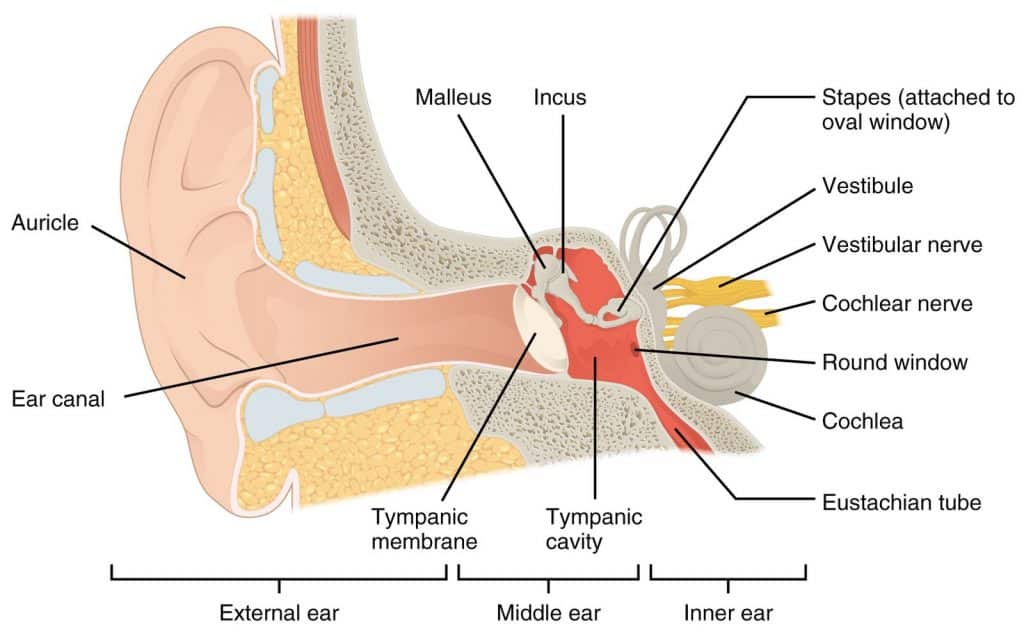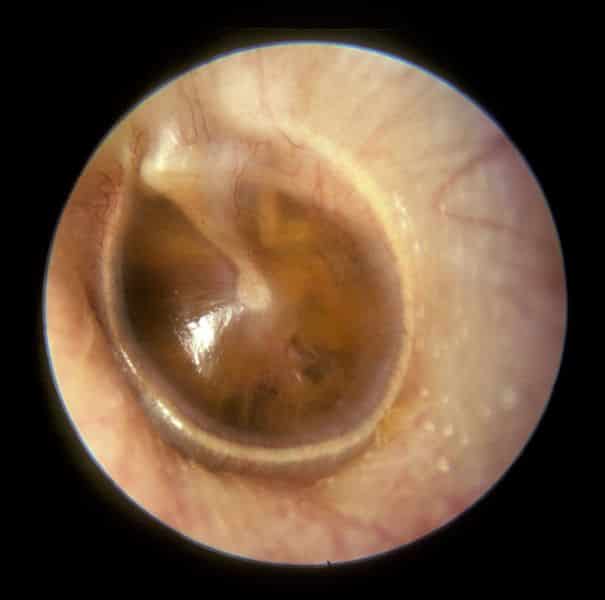Introduction
Otitis media with effusion (OME) is a condition that most commonly affects children, and it is often termed “glue ear“.
OME is caused by the build-up of a viscous inflammatory fluid within the middle ear cavity, which may or may not result in conductive hearing impairment.
In this article, we shall look at the aetiology, clinical features and management of otitis media with effusion.
Aetiology
The Eustachian tube (ET) is a bony-cartilaginous tube that connects the middle ear cavity to the nasal cavity (Fig. 1). The primary function of ET is to equilibriate the pressure within the middle ear with atmospheric pressure, allowing optimisation of sound conduction within the cavity. In children, the ET gets blocked more easily due to its anatomy of being shorter and more horizontal than in adults.
Blocked ET leads to impaired middle ear ventilation. Mucosal cells lining the cavity produce fluid due to negative pressures within the middle ear cavity, and subsequent mucosal inflammation increases the likelihood of middle ear infection (acute otitis media).
The condition is less common in adults, however will occur if there is any blockage of the ET, either from infective causes or from occlusive masses*.
*Consequently, any new case of persistent, unilateral OME in an adult should be investigated as a ‘red flag’ for a malignant underlying cause such as nasopharyngeal carcinoma
Risk Factors
The main risk factors for otitis media with effusion include:
- Bottle fed
- Household smoking
- Atopy (e.g eczema, asthma)
- Genetic disorders
- Mucociliary disorders, such as Cystic Fibrosis, Primary Ciliary Dyskinesia or Kartagener’s Syndrome
- Craniofacial disorders that lead to narrowing of the ET, such as Downs Syndrome
Clinical Features
The most common clinical feature of otitis media with effusion is difficulty hearing* (affecting one or both ears) and delay in speech and language development.
There may be a sensation of pressure inside the ear that may be accompanied by ‘popping’ or ‘crackling’ noises. Less commonly, the patient can also experience disequilibrium and vertigo. Patients may also present with recurrent acute otitis media.
On examination, the tympanic membrane will appear dull (Fig. 2) with a yellowish tinge, indicating fluid in the middle ear. There may also be a bubble or fluid-level seen behind the TM. The external ear will be normal.
*In young children this may be noticed as difficulty with attention at school or poor speech and language development
Investigations
In most cases, otitis media with effusion is diagnosed clinically on the basis of history and otoscopy findings.
Both pure tone audiometry and tympanometry are nearly always performed in such cases, which will reveal a conductive hearing loss and reduced membrane compliance (a type B tracing) respectively.
In adults, a full ENT examination should be performed for unilateral OME, including flexible nasoendoscopy (to exclude a post-nasal space mass).
Management
Otitis media with effusion in children can be managed in an outpatient setting. Approximately half of cases will resolve within 3 months, hence many cases are managed by ‘active surveillance’.
If no resolution is seen after 3 months, the management options can be divided into surgical and non-surgical:
- Non-surgical – hearing aid insertion
- Surgical – myringotomy and grommet insertion
Current guidance recommends the insertion of Grommets* for those with >3 months of bilateral OME and hearing level in better ear > 25-30dB HL. In certain cases, if there are significant concerns with speech and language development, grommets can be considered even if the hearing thresholds were better than 25dB HL.
Any child with persistent disease and multiple grommet insertion should be considered for potential adenoidectomy.
*Certain cases, such as patients with Down syndrome, first line therapy may actually be a hearing aid, as complications from grommet can be common

Figure 3 – Illustration of Grommet in-situ
Key Points
- Otitis media with effusion is caused by the build-up of a viscous inflammatory fluid within the middle ear
- Risk factors for developing the condition include being bottle fed, parenteral smoking, atopy, and some genetic disorders
- Patients will have a conductive hearing loss, with the tympanic membrane appearing dull on examination
- Most cases will resolve spontaneously, however medical and surgical options are available if symptoms do not resolve within 3 months


